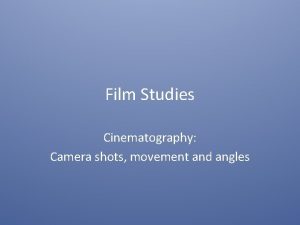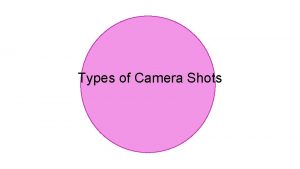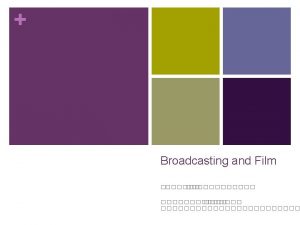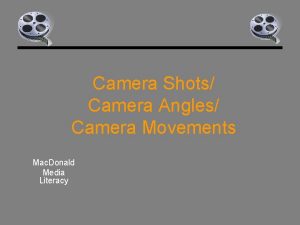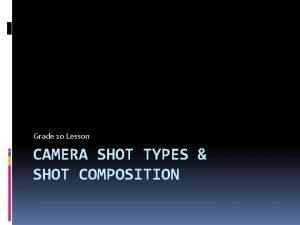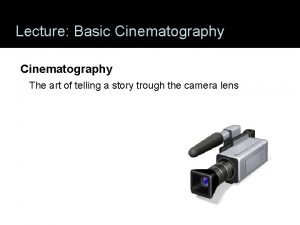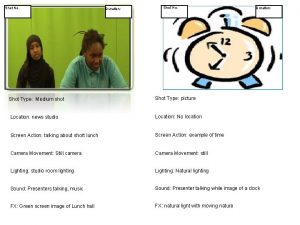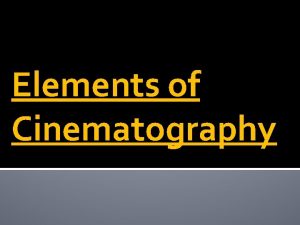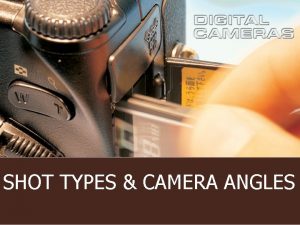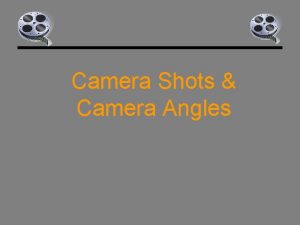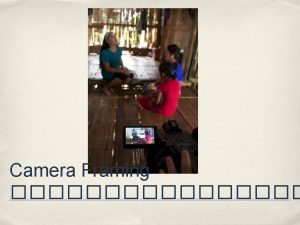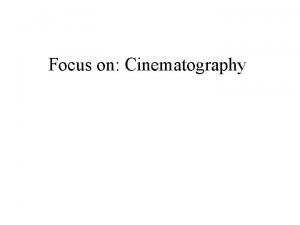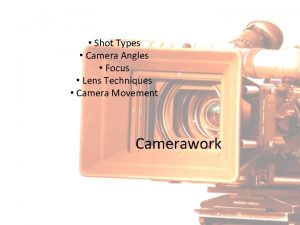Elements of Cinematography Camera Shot Types Every shot















- Slides: 15

Elements of Cinematography: Camera Shot Types

Every shot in your video should help convey the overall emotion of your project Emotion (in the form of fear, laughter, surprise, sadness, anger, boredom, etc. ) is the ultimate goal of each scene. The first consideration of where to place the camera should involve knowing what emotion you want the audience to experience at that particular time. You can control the intensity of that emotion by placing the camera close or far away from those eyes. A close-up will fill the screen with emotion, and pulling away to a wide angle shot will dissipate that emotion. A sudden cut from wide to close-up will give the audience a sudden surprise.

Using the different angles intelligently can help you create the exact emotional response you want from the audience to your video. . . !






CAMERA ANGLES OR POSITION. As well as thinking about the distance the camera is from the subject you should also think about the position of the camera in relation to the subject. If the camera is filming from above it is possible to make individuals within a frame appear weak. Conversely, by filming them from below and emphasizing their size so a subject may appear stronger. Camera angle - the scene appears unusual, "sinister" or that something may be wrong or about to happen. A bird’s-eye or worms-eye view is unnatural and draws attention just because of the angle itself. The more extreme the angle. . . The more emotional, unusual, or symbolic the shot can seem to a viewer.

LOW ANGLE SHOT. In this shot the camera is below the subject pointing upwards. It can be used to create the effect of making the subject seem overpowering, important or threatening. (photos courtesy of photolibrary wales www. photolibrarywales. com)

HIGH ANGLE SHOT. In this shot the camera is above the subject pointing down. It can be used to create the effect of making the subject seem vulnerable, insignificant or threatened. (photos courtesy of photolibrary wales www. photolibrarywales. com)

Other shots you may come across: TWO SHOT. Any shot which has two people in it. OVER THE SHOULDER SHOT. The audience is seeing over one person’s shoulder. (photos courtesy of photolibrary wales www. photolibrarywales. com)

POINT OF VIEW SHOT. A shot that shows what a character is looking at

DUTCH ANGLE. The camera is tilted or slanted creating a feeling of unease or disturbance. The verticals or horizontals are out of line. BIRD’S EYE SHOT. The camera is looking vertically straight down at the subject. (photos courtesy of photolibrary wales www. photolibrarywales. com)

CAMERA MOVEMENT: Cameras are usually placed on a tripod which allows it to move around on a pivot or remain stationary. Try to recognise the various results of moving the camera in different ways. Moving the camera from left to right is called panning and is used in the same way that we look at something by moving our head. The camera can also be made to move up or down- this is a tilt. Placing tracks alongside a moving subject allows a camera to follow the action - known as tracking. Harnesses worn to counterbalance the camera and cancel operator movement keep the camera steady when following rapid movement this is known as a steadicam. You may have seen steadicam operators running along the touchline at televised football matches.
 Master wide shot
Master wide shot Types of shots in film
Types of shots in film Extreme long shot cinematography
Extreme long shot cinematography Medium long shot
Medium long shot Camera shot types
Camera shot types Extreme long shot (els) or extreme wide shot (ews)
Extreme long shot (els) or extreme wide shot (ews) Camera shot types
Camera shot types Cinematography merit badge
Cinematography merit badge Citizen kane opening scene analysis
Citizen kane opening scene analysis Chungking express analysis cinematography
Chungking express analysis cinematography The sixth sense cinematography
The sixth sense cinematography Apa itu floor plan
Apa itu floor plan Batman the dark knight analysis
Batman the dark knight analysis Basic cinematography rules
Basic cinematography rules Pengertian graphein
Pengertian graphein Pavel russian bear
Pavel russian bear
